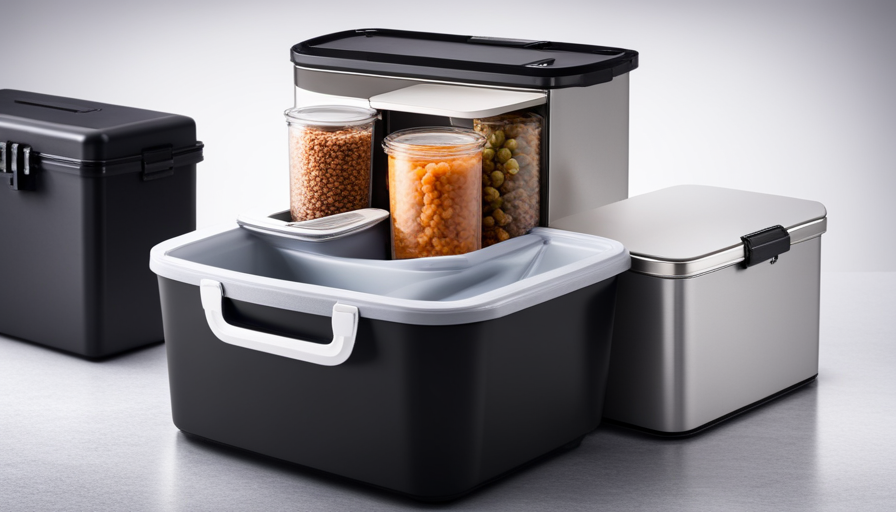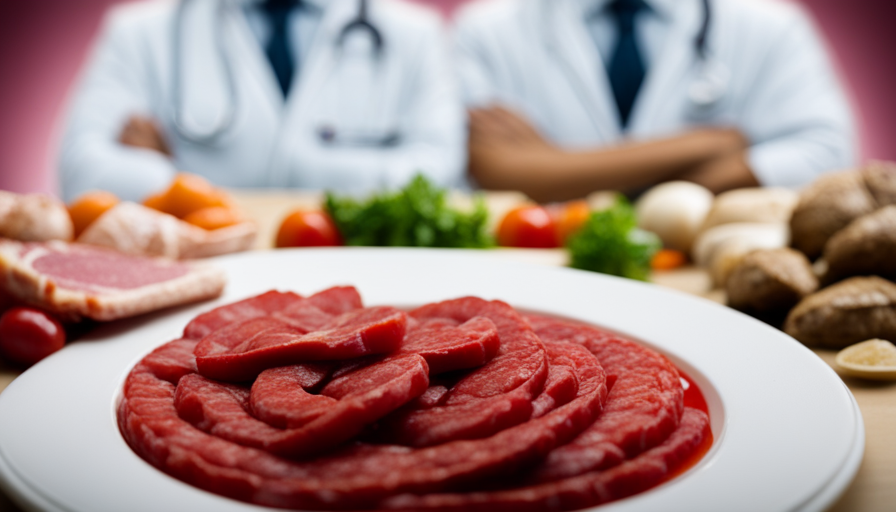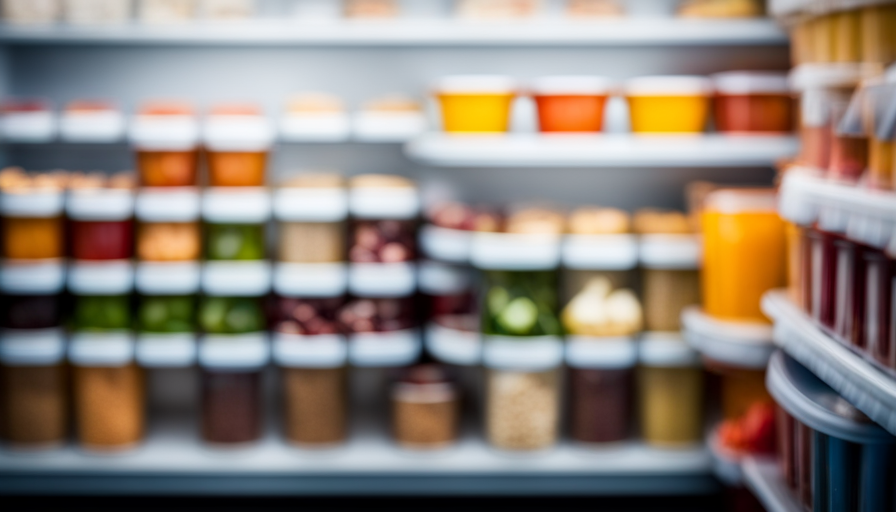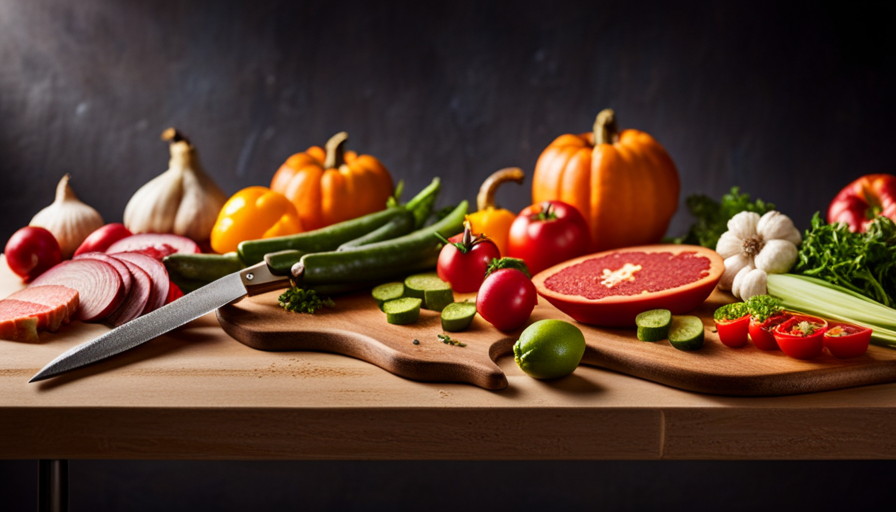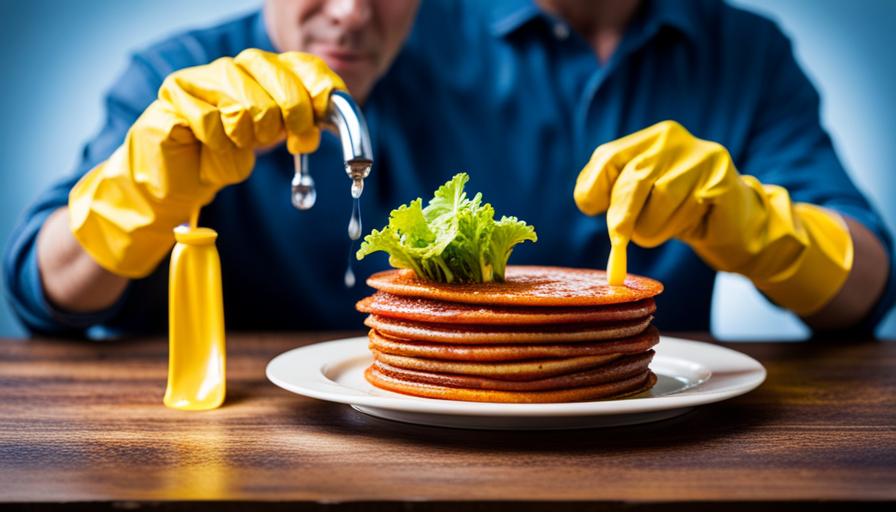Did you know that 46% of pet owners travel with their pets? If you are one of them and you provide your pet with a raw food diet, you might be wondering how to meet their nutritional needs while on the move.
Feeding your pet raw food while traveling requires careful planning and preparation, but it is definitely possible. In this article, we will guide you through the process of feeding your pet raw food while traveling, ensuring that they receive the nutrients they need to stay healthy and happy.
From choosing the right food storage containers to researching pet-friendly accommodations and finding local raw food suppliers, we will cover all aspects of feeding your pet raw food on the road.
So, if you’re ready to embark on a journey with your furry friend, keep reading to learn how to feed them raw food while traveling.
Key Takeaways
- Freeze-dried or dehydrated raw food options are convenient and nutritious for traveling.
- Proper food handling and storage in airtight containers is crucial for maintaining food safety.
- Portion control is important for your pet’s health while traveling, using pre-measured containers or a portable food scale.
- Slow feeding with a lightweight and portable slow feeder bowl can improve digestion and prevent overeating.
Planning Ahead: Preparing Your Pet’s Meals for Travel
Make sure you’re packing enough raw food for your pet’s meals while you’re traveling. Food prep and meal planning are essential to ensure your pet receives the proper nutrition while on the go.
Before embarking on your journey, take the time to plan out your pet’s meals and calculate the amount of food they will need for the duration of your trip.
Start by portioning out the raw food into individual meal-sized servings. This will make it easier to pack and ensure that you have enough food for each day. Consider using resealable bags or containers to keep the food fresh and prevent any leaks or spills.
If you’re traveling by car, pack a cooler with ice packs to keep the raw food chilled. This will help maintain its freshness and prevent any potential bacterial growth. Avoid leaving the food in direct sunlight or in a hot car, as this can lead to spoilage.
For air travel, check with the airline regarding their policies on transporting raw pet food. Some airlines may require you to freeze the food before packing it in your checked luggage. It’s important to follow these guidelines to ensure compliance and the safety of your pet’s food.
By planning ahead and preparing your pet’s meals for travel, you can ensure that they receive the necessary nutrients while on the go. Proper food prep and meal planning will help to keep your pet happy and healthy throughout your journey.
Choosing the Right Food Storage Containers
Don’t forget to pick the perfect containers to keep your furry friend’s fresh and nutritious meals safe and secure on the go! When it comes to choosing the right food storage options for your pet’s raw food, there are a few factors to consider.
First, you want to make sure the containers are airtight to prevent any leaks or spills during travel. Look for containers with secure lids that seal tightly to keep the food fresh and free from contamination.
Additionally, opt for containers that are made from food-grade materials, such as stainless steel or BPA-free plastic, to ensure proper food handling.
Stainless steel containers are a popular choice for storing raw pet food while traveling. They’re durable, easy to clean, and resistant to odors. Plus, stainless steel containers are non-toxic and don’t leach harmful chemicals into the food.
Another option is BPA-free plastic containers, which are lightweight and convenient for travel. Just make sure to choose containers that are specifically designed for food storage and are labeled as BPA-free.
Remember, proper food handling is crucial when feeding your pet raw food while traveling. Always wash your hands thoroughly before and after handling the food, and clean the containers with hot, soapy water after each use.
By choosing the right food storage containers and practicing proper food handling techniques, you can ensure that your pet’s meals remain fresh, nutritious, and safe while you’re on the go.
Researching Pet-Friendly Accommodations
When looking for accommodations that are suitable for your furry friend, be sure to research pet-friendly options to ensure a comfortable and enjoyable stay. Researching pet-friendly accommodations involves finding places that not only allow pets but also provide the necessary facilities and amenities to cater to their needs. Start by checking online platforms that specialize in pet-friendly accommodations or reach out to travel agencies that specifically cater to pet owners.
To make your stay even more convenient, it’s essential to find accommodations that are close to local raw food suppliers. This way, you can easily access the raw food your pet needs while on the road. When researching pet-friendly accommodations, consider creating a table like the one below to keep track of the options available:
| Accommodation | Pet Policy | Proximity to Raw Food Suppliers |
|---|---|---|
| Hotel A | Allows pets up to 25 pounds | 1 mile |
| Resort B | Allows all pets | 2 miles |
| Cabin C | Allows pets with an additional fee | 0.5 miles |
By using this table, you can compare different accommodations based on their pet policies and proximity to raw food suppliers. This will help you make an informed decision and choose the best accommodation for both you and your pet.
Packing Essential Feeding Supplies
If you want your furry friend to dine in style on your adventures, packing essential feeding supplies is an absolute must! When it comes to feeding your pet raw food while travelling, you need to make sure you have the right tools and equipment to ensure their meals are safe and convenient.
Here are four items you should consider packing in order to provide your pet with a seamless feeding experience:
-
Pet Food Packaging: Invest in high-quality, travel-friendly packaging for your pet’s raw food. Look for options that are airtight, leak-proof, and easy to store. This will help keep the food fresh and minimize the risk of any spills or contamination.
-
Portable Food Containers: Opt for compact and lightweight food containers that are easy to carry and clean. Look for ones with separate compartments for storing dry and wet food, as well as collapsible options that can save space in your luggage.
-
Travel Bowls: Pack collapsible or foldable bowls that are specifically designed for travel. These bowls are convenient to carry and can be easily cleaned. Look for ones made from durable materials that are also dishwasher safe.
-
Feeding Mats: Consider packing a portable feeding mat to keep your pet’s dining area clean and hygienic. Look for mats that are waterproof and easy to wipe clean. This will prevent any messes from spreading and make cleaning up a breeze.
By packing these essential feeding supplies, you can ensure that your pet’s raw food diet remains intact even when you’re on the go.
Utilizing Freeze-Dried or Dehydrated Raw Food Options
Make mealtime a breeze on your adventures by trying out freeze-dried or dehydrated options for your furry friend’s dining pleasure. When it comes to feeding your pet raw food while traveling, freeze-dried or dehydrated options can be a convenient and nutritious choice. Many pet owners find themselves caught in the freeze-dried vs raw food debate, as both options have their pros and cons.
Freeze-dried raw food is made by freezing the raw ingredients and then removing the moisture through a process called sublimation. This method helps to retain the nutritional value of the food while making it lightweight and easy to carry. On the other hand, dehydrated raw food is made by slowly drying out the ingredients, which also helps to preserve the nutrients.
To help you understand the benefits of feeding your pet freeze-dried or dehydrated raw food, take a look at the table below:
| Freeze-Dried Raw Food | Dehydrated Raw Food |
|---|---|
| Convenient to pack | Lightweight |
| Long shelf life | Easy to rehydrate |
| Retains nutrients | Retains nutrients |
By opting for freeze-dried or dehydrated raw food options, you can ensure that your pet still enjoys the benefits of a raw food diet even while on the go. Remember to consult with your veterinarian before making any changes to your pet’s diet to ensure it is suitable for their specific needs.
Managing Portion Control on the Road
Maintaining portion control on the road can be a challenge, but it’s essential for keeping your furry friend healthy and happy during your adventures. Here are some portion control tips and tricks to help you manage your pet’s raw food while traveling.
First and foremost, it’s important to measure out the appropriate portion sizes for your pet. This will ensure that they’re getting the right amount of nutrients without overeating. Consider investing in a portable food scale or pre-measured containers to make portioning easier.
Next, managing raw food storage is crucial when it comes to portion control. Keep your pet’s raw food in airtight containers or resealable bags to maintain freshness and prevent spoilage. It’s also a good idea to freeze individual meal portions in advance, so you can thaw them as needed while on the road.
When feeding your pet, try to stick to a consistent feeding schedule. This’ll not only help with portion control but also with maintaining their digestive health. It’s also important to have access to fresh water at all times, so make sure to pack a portable water bowl and refill it regularly.
By following these portion control tips and managing raw food storage effectively, you can ensure that your pet stays healthy and satisfied while traveling.
Finding Local Raw Food Suppliers
When you’re on the road with your furry friend, it can be as exciting as discovering a hidden treasure to find local suppliers who offer fresh, nutritious raw meals for your four-legged companion.
One option to consider is local raw food delivery services. These services provide a convenient way for you to access quality raw food for your pet without the hassle of searching for suppliers yourself. By simply placing an order online or making a phone call, you can have raw meals delivered right to your doorstep or even to your current location while traveling.
Another option is to explore pet-friendly restaurants in the area. While not all restaurants may offer raw food specifically, many establishments are willing to accommodate special dietary requests for pets. By calling ahead or researching online, you can find restaurants that are willing to prepare a fresh, raw meal for your pet. This allows you to enjoy a meal out while ensuring your furry friend gets the nutrition they need. Additionally, some restaurants may even have a designated pet menu or special treats available for purchase.
Overall, finding local raw food suppliers and pet-friendly restaurants can make feeding your pet raw food while traveling much easier. It allows you to provide your pet with the best nutrition possible while still enjoying your adventures on the road.
Ensuring Food Safety and Hygiene
To ensure the safety and hygiene of your furry companion’s meals, it’s important to carefully source and handle the fresh, nutritious ingredients you provide while you’re on the go. Here are some tips to help you maintain food safety and hygiene while traveling and feeding your pet a raw food diet:
-
Food storage alternatives: Invest in a portable cooler or insulated bag to keep the raw ingredients fresh and prevent bacterial growth. Consider using freezer packs or ice cubes to maintain the temperature within the safe range.
-
Benefits of raw food diet: Raw food diets for pets have gained popularity due to their numerous benefits. They provide essential nutrients, enzymes, and vitamins that can improve digestion, promote healthier skin and coat, and boost the immune system. Additionally, raw food diets can help reduce allergies and intolerances in pets.
-
Proper handling: When handling raw food, it’s important to wash your hands thoroughly before and after. Use separate cutting boards and utensils for raw pet food to avoid cross-contamination with human food. Also, ensure that the raw food is properly thawed before feeding it to your pet.
By following these guidelines, you can ensure that your pet’s meals remain safe and nutritious while you’re traveling and feeding them a raw food diet.
Introducing Slow Feeder Bowls for Travel
Introducing slow feeder bowls can revolutionize mealtime for your furry companion, making it more engaging and enjoyable even on the go. These slow feeder alternatives are designed to slow down your pet’s eating pace, promoting better digestion and reducing the risk of choking or bloating.
They come in various shapes and sizes, catering to different breeds and sizes of pets.
The benefits of slow feeding for pets are numerous. Firstly, it helps prevent overeating, which is especially important when you’re traveling and your pet may be less active than usual. By slowing down their eating, slow feeder bowls can help maintain a healthy weight for your pet.
Additionally, slow feeding can improve their dental health by encouraging them to chew their food thoroughly, reducing the chances of dental issues like plaque and tartar buildup.
Moreover, slow feeder bowls provide mental stimulation for your pet. By requiring them to work for their food, these bowls tap into their natural instincts and keep them entertained. This can be particularly beneficial during long journeys or when your pet is confined to a small space.
When choosing a slow feeder bowl for travel, opt for a lightweight, portable, and durable option that’s easy to clean. Look for bowls with non-slip bases to prevent spills and messes in the car or hotel room.
With the right slow feeder bowl, you can ensure that your pet enjoys their raw food meals while traveling, promoting their overall health and well-being.
Maintaining a Consistent Feeding Schedule
Maintaining a consistent feeding schedule ensures that your furry friend stays happy and satisfied throughout their journey. Whether you’re traveling across time zones or simply on a short road trip, it’s important to stick to your pet’s regular routine as much as possible.
Here are some tips to help you maintain a routine and deal with time differences:
-
Plan ahead: Research the time zone differences at your destination and adjust your pet’s feeding schedule accordingly. Gradually shift their meal times a few days before the trip to help them adjust.
-
Use timers: Invest in automatic feeders that allow you to set specific meal times. This ensures that your pet will be fed even if you’re not available.
-
Portion control: Measure out your pet’s food into individual portions for each meal. This way, you can easily feed them at the appropriate times without worrying about overfeeding or underfeeding.
-
Stick to familiar foods: While traveling, it’s best to stick to the same brand and type of food that your pet is used to. Sudden changes in diet can upset their stomachs and cause discomfort.
By maintaining a routine and making adjustments for time differences, you can keep your pet’s feeding schedule consistent and ensure they stay happy and nourished during your travels.
Frequently Asked Questions
How do I ensure my pet’s raw food stays fresh while traveling?
To keep your pet’s raw food fresh while traveling, follow these tips for packing it on road trips.
First, invest in a quality cooler or insulated bag to maintain the food’s temperature.
Pack the food in individual, airtight containers or resealable bags to prevent spoilage and leaks.
Keep the cooler in a cool and dark area of your vehicle.
Additionally, consider freezing the food before the trip to extend its freshness.
Are there any specific guidelines for packing raw food for air travel?
When it comes to packing raw food for air travel, there are specific guidelines you should follow. First, ensure that the raw food is properly sealed to prevent any leakage or contamination. Use airtight containers or vacuum-sealed bags to maintain freshness.
When handling raw food in airports, be aware of any regulations or restrictions on carrying such items. It’s also a good idea to pack ice packs or frozen gel packs to keep the food at a safe temperature during the journey.
Can I feed my pet freeze-dried or dehydrated raw food exclusively while on the road?
While on the road, you can feed your pet freeze-dried or dehydrated raw food exclusively. This type of food has several benefits. Firstly, it retains most of the nutrients found in raw meat, providing a balanced diet for your pet. Secondly, it is lightweight and easy to pack, making it convenient for travel. To transition your pet to this type of food, start by mixing small amounts with their current food and gradually increase the proportion over a few days. Remember to provide fresh water at all times.
What should I do if I can’t find any local raw food suppliers in the area I’m traveling to?
If you can’t find any local raw food suppliers in the area you’re traveling to, don’t worry, there are still alternative pet food options available. Look for pet stores or supermarkets that carry high-quality canned or freeze-dried pet food. These options can provide a balanced diet for your pet while on the go.
Additionally, managing pet food storage on the go can be challenging, but consider using portable coolers or containers specifically designed for storing pet food to keep it fresh and safe for your furry friend.
Are there any special considerations for feeding raw food to my pet in a hotel or rental accommodation?
When staying in pet-friendly accommodations, there are a few special considerations for feeding your pet raw food. Firstly, check with the hotel or rental accommodation to ensure that they allow raw food in the room. If not, consider alternative options such as using freeze-dried raw food or finding local pet stores that carry raw food.
Additionally, bring your own cooler or ask the accommodation if they have refrigeration facilities available. Always clean up after your pet to maintain a clean environment.
Can I Find Raw Ingredients for My Pet’s Food While Travelling?
While traveling, finding raw ingredients for pet food might be a challenge. However, with a little research, you can locate pet stores or farmers’ markets that offer fresh, quality raw ingredients for pet food. Just be sure to check local regulations and guidelines for transporting or exporting animal products.
Conclusion
In conclusion, feeding your pet raw food while traveling requires careful planning and preparation. By researching pet-friendly accommodations and finding local raw food suppliers, you can ensure that your pet receives the nutrition they need while on the go.
It’s important to note that, according to a survey conducted by the American Pet Products Association, 70% of pet owners consider their pets’ nutrition to be a top priority. This statistic highlights the growing trend of pet owners seeking out healthier food options for their furry friends, even when traveling.
So, whether you’re going on a short road trip or a long vacation, remember to prioritize your pet’s diet and make the necessary arrangements to keep them happy and healthy.

